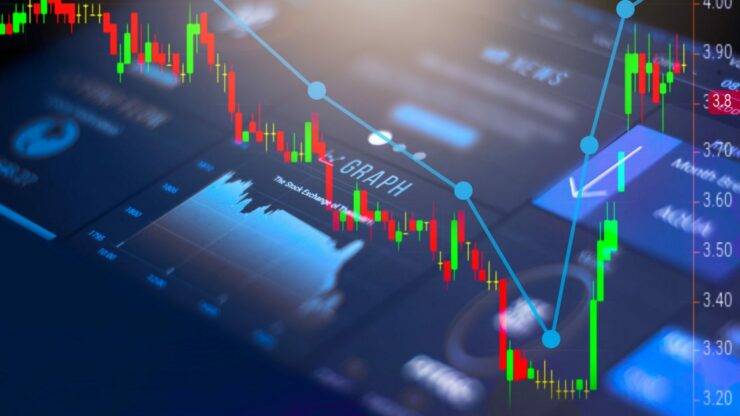Don’t invest unless you’re prepared to lose all the money you invest. This is a high-risk investment and you are unlikely to be protected if something goes wrong. Take 2 minutes to learn more
The auto trading phenomenon allows you to buy and sell assets with the assistance of an algorithm. In some cases, the auto trading robot might scan the financial markets looking for trading opportunities and then send you a signal with information on what order to place.
In other cases, the auto trading platform might offer a 360-degree autonomous service – meaning that the algorithm will trade on your behalf. Whichever option you feel more comfortable with, it’s crucial that you do some research on the auto trading provider before parting with your cash.
AvaTrade - Established Broker With Commission-Free Trades

- Minimum deposit of just 250 USD to get lifetime access to all the VIP channels
- Awarded Best Global MT4 Forex Broker
- Pay 0% on all CFD instruments
- Thousands of CFD assets to trade
- Leverage facilities available
- Instantly deposit funds with a debit/credit card

After all, much of the industry is dominated by scam artists who make super-bold claims on the amount of ‘guaranteed’ profits you can make. In this guide, we explore the ins and outs of how auto trading works and what you need to do to find the best providers of 2026.
Note: The most important thing is that you are able to validate the win rate claims of your chosen auto trading provider. This might come in the form of a demo account, free trial, or money-back guarantee.
What is Auto Trading?
In a nutshell, auto trading is the process of buying and selling financial instruments in an automated manner. In the vast majority of cases, you will be relying on a pre-programmed algorithm that is backed by AI or machine learning. The algorithm will then be tasked with scanning the financial markets – whether that’s forex, stocks, commodities, or cryptocurrencies – looking for potential trading opportunities. If and when the auto trading software does just that, it will then look to capitalize by creating a risk-averse trade.
For example, let’s say that the auto trading bot is tasked with researching major forex pairs like EUR/USD. With the assistance of key technical indicators like Bollinger Bands and the RSI, the auto bot might be programmed to place a buy order when the pair is oversold. This is with the view of buying the asset when – on the balance of probabilities, a market correction is imminent. When the algorithm is triggered, it then ascertains that EUR/USD should be traded with an entry price of 1.105.

Depending on the type of auto trading provider you sign up with, the bot might send you a real-time signal with details of its findings, as well as the entry and exit order prices that need to be placed. You then have the capacity to research the signal yourself, or simply proceed to place the orders. Alternatively, the auto trading provider might offer an all-in service, meaning that the respective entry and exit orders will be placed on your behalf.
If this is the case, you get to trade in a fully passive manner – with no requirement to have any skills or experience in the financial markets. As great as auto trading bots can be for your long-term investment goals, it is important to note that much of the space is dominated by scam providers. That is to say, while the provider might promise ‘guaranteed’ returns of 90% or more, this is rarely the case. As such, it is crucial that you do your homework before buying an auto trading robot for the first time.
What are the Pros and Cons of Auto Trading?
The Pros The Cons
Types of Auto Trading Providers
So now that you know the basics of what auto trading actually is, we are now going to break down the different types of providers active in the market.
Semi-Auto Trading via Signals
When we refer to semi-auto trading providers, these are platforms that automate part, but not all, of the end-to-end investment process. In the vast majority of cases, semi-auto online trading platforms offer trading suggestions via signals. Let’s take the Learn 2 Trade algorithm as a prime example. The underlying technology – which is supported by a highly advanced algorithm, scans the forex trading and cryptocurrency markets on a 24/7 basis. Once the algorithm finds a potential money-making opportunity, it will then send a signal to members of the service.
For example, the signal might contain the following information:
- Asset: BTC/USD
- Signal: RSI suggesting overbought territory
- Order: Sell
- Entry: $9,689
- Stop-Loss: $9,980
- Take-Profit: $9,410
As you can see from the above example, 90% of the end-to-end investment process has been automated. This is because the trader was not personally required to research the financial markets. Instead, this part of the process was assigned to a pre-programmed algorithm.
Once the signal is received by the trader, they then have three options. The trader can choose to research the findings themselves before placing the trade; place the trade straight away; or simply place no trades at all. Crucially, this type of auto trading service is best suited for those of you that want to benefit from the advanced capabilities of AI and machine learning, but at the same time, have an element of control over your trades.
Fully-Automated Trading
As the name suggests, fully-automated providers take care of the entire end-to-end investment process. That is to say, once your funds have been invested with the provider, you won’t be required to do anything else.
In terms of the fundamentals, the research process works largely the same as what we discussed in the section above, insofar that the technology will look to find day trading opportunities around the clock. However, the key difference is that once an opportunity has been found by the algorithm, it will proceed to place the trade on your behalf.

On the one hand, this particular option is ideal if you do not have any knowledge or experience of the financial markets. This is because you will not be required to research the trading signals that the algorithm finds. Instead, you are entrusting the bot to place buy and sell orders for you. On the other hand, you really need to be confident that the fully-automated trading service is legitimate. After all, you don’t want to be in a position where the bot is placing losing trade after losing trade.
Auto Mirror Trading
The third option that you have at your disposal is to use a mirror trading service. This is where you choose a seasoned investor that has a verifiable track record in the financial markets, and then copy their portfolio like-for-like.
You will also be mirroring any future trades that the individual makes. This allows you to benefit from the skills of a highly seasoned trader, while at the same time not being required to understand how investments work.
In this sense, mirror trading still follows the same principles as conventional AI-based auto trading, as the entire process is passive. In terms of providers, platforms like eToro allow you to copy trade with a minimum investment of $200, and you get a full break down of the trader’s historical track record at the site.
Alternatively, you might want to consider a PAMM account provider. This is where your money is pooled together with an expert trader. The trader will then buy and sell assets on your behalf. In return, they will earn a commission on any profits that they make for you.
What Assets Can I Auto Trade?
The vast bulk of the auto trading space is dominated by forex and cryptocurrencies. This is because both asset classes trade on a 24/7 basis, and they both benefit from heaps of liquidity and trading volumes. With that said, there are auto trading platforms that cover most asset classes. This includes everything from stocks, indices, energies, hard metals, interest rates, and bonds.
Crucially, it’s best to choose an auto trading bot that is involved in an asset class that you feel comfortable trading. For example, if you’re looking to gain exposure to the multi-trillion dollar forex space, it’s best to stick with a provider that targets major and minor currencies.
How do Auto Trading Investments Work?
When it comes to the investment process, this all depends on the type of auto trading system that you wish to employ. With that being said, most of our readers prefer to utilize a fully-automated trading service, as there is no requirement to actively research or place orders.
As such, the following steps show you how an investment would work when using an auto trading provider that offers an all-in service.
✔️ Minimum Investment Amount
First and foremost, you will need to meet a minimum investment amount to activate the auto trading service. The specific amount can vary quite considerably depending on the provider and account type you opt for. In most cases, we find that minimum deposits start at around $250.
✔️ Activate Automated Service
The auto trading provider will then need to get authorization from you. This confirms that you are happy for the provider to buy and sell assets on your behalf. If you don’t activate the automated feature, then you will simply receive forex signals. You’ll then need to act on the signals yourself.
✔️ Set Trade Parameters
You will then need to set some trading parameters. After all, you likely won’t want the bot to trade your entire balance on a single order. As such, enter the maximum amount that you wish to place on each signal. For example, let’s say that you deposited $1,000 at the platform. If you don’t want to risk more than 5% of your balance per trade, make sure you specify this.
You will also have the freedom of entering some stop-loss and take-profit targets. For example, you might not want to lose more than 3% on each trade. Similarly, you might want to target profits of 5% per trade, and close the position when this is triggered. With that being said, it might be best to leave the suggested entry and exit prices to the algorithm.
✔️ Birds-Eye View
Each and every trade that the auto trading bot places on your behalf will be fully transparent from within your account portal. Not only does this allow you to gauge how much money you are making or losing, but crucially – whether or not the bot is right for your personal requirements. Even if the bot is making you good money, you might find that its strategies are too risky for your liking.
✔️ Withdrawals
Most auto trading platforms in the space allow you to withdraw your money as and when you see fit. It is really important that you establish this before signing up, as you don’t want to have your funds locked up for a minimum redemption period.
Once you do request a withdrawal, the funds will be sent back to your payment method within a few days.
Making Money at an Auto Trading Platform
When it comes to making money at your chosen auto trading platform, this is dependent on the ROI (return on investment). It’s not as simple as multiplying your overall investment by the win rate, as it also depends on how much is being staked per trade. In other words, if you deposit $250 into the platform, the bot isn’t going to be placing $250 on each and every trade that it makes. Instead, it might allocate 1-2% on a medium-to-high risk trade, and 3-5% on a low-to-medium risk trade.
For example, let’s say that you deposit $5,000 into a platform that offers a fully-automated trading service.
- The bot risks 5% on trade 1, which amounts to $250. The trade makes a 4% profit ($10)
- The bot risks 2% on trade 2, which amounts to $100. The trade makes a 30% profit ($33)
- The bot risks 1% on trade 3, which amounts to $50. The trade loses 1.5% ($0.75)
As you can see from the above, the bot made $10 and $33 from trades 1 and 2, and then lost $0.75 on trade 3. This takes the overall profit in dollars and cents to $42.25. In terms of your ROI, this amounts to 0.845%. Although this number might sound small, it is important to remember that this relates to just three trades.
Auto trading robots will often place dozens of trades per day, so your gains can really start to add up. Crucially, the above examples highlight a sensible risk-averse strategy where no more than 5% of the portfolio was staked on a single trade. If you want to go even more conservative with this, you reduce the maximum allocation percentage even further.
How Much do Auto Trading Robots Cost?
Once again, there really is no hard and fast rule as to how much an auto trading system will cost you, as it can vary so widely. With that being said, most of the providers that we recommend operate on a commission-based model. This means that the platform will earn a percentage of each and every winning trade that they make on your behalf.

- You invest $2,000 into the auto trading platform
- The platform make 100 trades throughout the month
- The ROI amounts to 15%, which equates to $300
- The platform will take its 10% commission, which is $30
- This leaves you with $270 in gains
We would argue that a commission-structure as detailed above is by far the best pricing model available to you. The overarching reason for this is that the platform only makes money when they are profitable. As such, the provider is financially motivated to place risk-averse trades on your behalf, with the view of maximizing your ROI. Crucially, the more the auto trading platform makes for you, the more they make for themselves.
How to Choose an Auto Trading Site
Without a shadow of a doubt, the most difficult part of the auto trading process is finding a credible provider. As we have noted throughout our guide, most providers in the space will claim to make guaranteed double-digit returns. There is no such thing as guaranteed profit in the financial markets, as even the most successful trading houses in the world will have the occasional losing month. This is just the nature of the game.
As such, there are a number of factors that you need to look out for when choosing an auto trading platform.
Verifiable Results
The most important metric that you need to look out for is whether or not you have the capacity to validate the win ratio that the provider advertises. For example, if we told you that we could make you a guaranteed ROI of 40% per month, how would you know if we were telling the truth? In the vast majority of cases, you don’t – as you won’t have access to the auto trading robot until you make an investment.

On the one hand, we do understand why providers do not publish their historical trading results in the public domain. It can take many years to perfect the underlying algorithm, so it’s fair that the platform does not want this information being distributed freely. On the other hand, the provider should install a number of safeguards that allow you to verify the effectiveness of the service before committing large sums of capital.
For example, if the platform offers a demo account, this will allow you to test each and every signal out before risking your own funds. It’s also notable if the provider offers a free trial or money-back guarantee, as this will allow you to withdraw your investment straight back out in the event you are not satisfied.
Reputation and Trust
One of the best ways to gauge the credibility of an auto trading robot is to do some homework of your own. The internet is jam-packed with reviews and ratings of auto trading services, so you’ll get to feed on the experiences of current and past users. If the general consensus is that the trading robot is working well, this is a good starting point.
You should also assess the credibility of the provider itself. For example, who is behind the auto trading robot, and how long has the platform been in business? Is there a way to speak with the provider on the telephone, or does everything need to go through emails?
Transparency
Most auto trading providers in the space offer a fully transparent service. By this, we mean that you get to view each and every trade that the platform makes on your behalf. Crucially, this gives you a full birds-eye view of the type of risks and strategies that the bot is taking. With that said, some providers simply display your profit and loss figures, without you knowing where your invested funds are actually going. We would suggest avoiding platforms like this.
Costs and Commissions
You also need to assess the cost of using the auto trading service. We would suggest taking a step back in this respect, as you should never base your decision purely on price. For example, let’s take two separate auto trading platforms – one that charges a 30% commission, and one that charges 5%.
Your first thought might be to choose the platform that offers a super-competitive 5% commission, as you think it offers tremendous value. However, this might not necessarily be the case. For example, what if the more expensive provider makes an average return of 20% per month, while the more cost-effective platform averages 3%?
Well, let’s take a quick at the numbers – based on a $10,000 investment
- Provider 1 makes a return of 3%, meaning your $10,000 investment yields $300 per month. The provider charges 5% in commission, so you walk away with $285 in profit.
- Provider 2 makes a return of 20%, meaning your $10,000 investment yields $2,000 per month. The provider charges a whopping 30% in commission, so you walk away with $1,400 in profit.
As you can see from the above example, you are far better to choose a provider that charges a high commission in return for above-average gains. In other words, you should expect to pay more for a proven system that consistently yields an attractive ROI.
Asset Classes
You then need to assess the types of assets that the provider trades. For example, are you looking for an auto trading robot that buys and sells currencies, or are you more interested in commodities like gold, oil, and gas? With that said it might be worth choosing a provider that gives you exposure to multiple asset classes. In doing so, you’ll stand the best chance possible of creating a highly diversified portfolio.
Best Auto Providers Sites of 2026
Looking for the best auto trading platforms of 2026, but not too sure where to start? Below, you will find our top-rated providers currently in the market. As always, be sure to perform your research before signing up!
Conclusion
Auto trading providers allow you to access the financial markets completely passively. By allowing a highly advanced algorithm to research and place trades on your behalf, you stand the chance of making a profit without needing to do any of the work. This is especially useful if you have little to no experience in the investment space or you simply don’t have the time to trade.
On the flip side, the difficult part is finding an auto trading platform that you can trust. After all, it’s easy to make bold claims – so you need to be able to verify the legitimacy of the provider prior to parting with your money. To help you along the way, we have discussed our top auto trading platforms of 2026. As always, just make sure that you do your homework before getting started – as research is crucial!
AvaTrade - Established Broker With Commission-Free Trades
The Crypto Trader is a group reserved exclusively to people who jumped on the insane returns that Bitcoin offers and have quietly amassed a fortune in doing so. Our members enjoy retreats around the world every month while they make money on their laptop with just a few minutes of “work” every day

- Pay 0% on all CFD instruments
- Thousands of CFD assets to trade
- Leverage facilities available
